These highlights chronicle the year 2023. The year runs generally
"backwards" on this page. In crediting records of vagrant or unusual birds, I always try to credit the finder(s) of the rarity. There will be times when complications arise with credit (e.g., one or more observers find a bird but others are the ones to actually identify it). There are times when a bird is properly identified only days later after photo review.
The abbreviation "MTY" means "Monterey County"
in the text below. Text by Don Roberson. Photos on this page
are copyrighted by the photographers to whom they are
attributed, and may not be reproduced in any form (including
other web sites) without the express consent of the photographer. |
| |
A new on-line tool for birders came to California in 2023. Developed for Ohio a few years ago, it has now spread to California and 20 other states, plus Ontario, Canada. Called Birding Hotspots, it is meant to aid eBirders to learn about the eBird Hotspots in their State and County. It is a private volunteer project not associated directly with eBird or Cornell. Volunteers in many counties — including Monterey County — are adding photos and text to each Hotspot to describe the site, how to reach it, provide birding tips, highlight birds of interest, and state whether there are restrooms or wheelchair access at each site.
 California has over 16,000 eBird Hotspots, so only about a thousand have content currently, but additional Hotspot details come on line every day. As of this writing, Monterey County (MTY) had 358 Hotspots. Two-thirds of them have at least one photo, and just over 50% have both photos and written content. We have almost 10 contributors that have completed or worked on site descriptions — more are welcome. Check it out. I've included links to some completed MTY Hotspots in the discussions below. California has over 16,000 eBird Hotspots, so only about a thousand have content currently, but additional Hotspot details come on line every day. As of this writing, Monterey County (MTY) had 358 Hotspots. Two-thirds of them have at least one photo, and just over 50% have both photos and written content. We have almost 10 contributors that have completed or worked on site descriptions — more are welcome. Check it out. I've included links to some completed MTY Hotspots in the discussions below. |
|
| |
|
We reference below a pair of Swainson's Hawk in apparent courtship behavior at the Marina Landfill on 13 May (Brian L. Sullivan et al.). Brian and others checked the Landfill several times in June and found both dark-morph adults hunting over the dump.
After obtaining special permission to access non-public land, an effort was made on 24 June to see if the pair were attempting to breed locally. A team of four locals (Brian Sullivan, Paul Fenwick, Rita Carratello, Don Roberson) found a nest in the riparian corridor of the Salinas River near the landfill. The male was seen delivering a prey item into the crown of a tall willow during the visit (photo upper left, © Rita Carratello). This led to the discovery of the female, seemingly incubating eggs, on a well-hidden nest (photo lower left, © D. Roberson; you can just see her head as she is looking at us).
This is the first known nest in the lower Salinas Valley since an egg set was collected in 1915 (Roberson 2002). The last breeding pair in the county was in the mid-1970s far to the southeast in Cholame Valley. There have been multiple nesting pairs in San Benito County, east of us, in recent years. It is certainly encouraging that at least one pair is now nesting again in MTY. |
|
| |
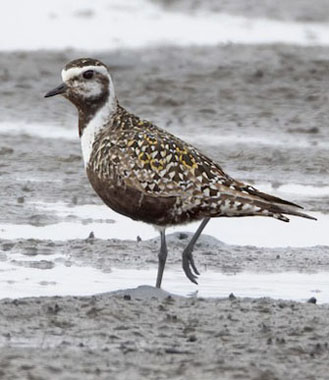 |
Surely the rarest vagrants of the spring were an American Golden-Plover and a Lucy's Warbler; each a one-hour wonder.
The golden-plover (left, © Mark Chappell), well into alternate plumage, was at Moss Landing on 9 June. There are just 6 MTY records of spring migrants, between18 Apr–18 June, back to 1987.
The Lucy's Warbler was working the canopy of cottonwoods along the Carmel River at Rancho Cañada in Palo Corona Reg. Park on 25 May (right, © Brian L. Sullivan). There are ~50 MTY records for fall and winter, but this was the first for spring. |
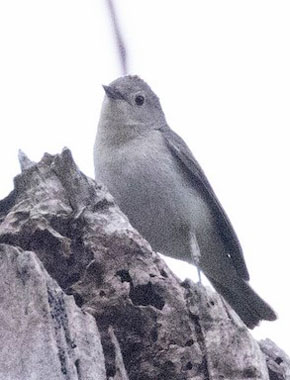 |
|
| |
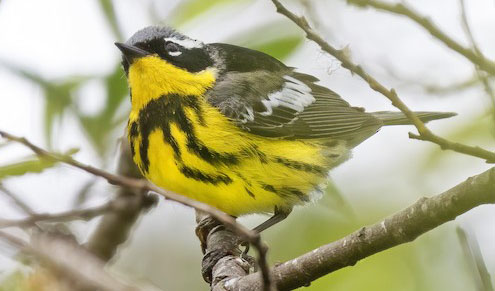 |
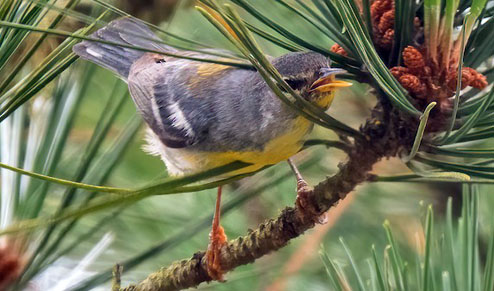 |
A gallery of colorful "eastern" warblers appeared in late May & early June. This timing is perfect for vagrant warblers but one never knows which species will be found in any particular year. This year highlights included a breeding-plumaged Magnolia Warbler singing at Rancho Cañada from 25-28 May (upper left, found by Rita Carratello while leading her adult education class, photo 26 May © Mark Chappell). We now have over 100 records for Magnolia Warbler, but the vast majority were in fall migration. There are only 8 MTY records of spring Magnolias; all in late May or early June.
There were actually 7 Northern Parula this spring: 3 in May but 4 singing males just during 11-12 June, and two of them were counter-singing to each other in Carmel Meadows on 11 June (one of those shown above right, found by Michael Rieser, photo © Mark Chappell). Unlike Magnolia Warbler, N. Parula records are about equally split between spring and fall vagrants.
The only American Redstart of the spring was in Rita Carratello/Don Roberson's back yard 28-29 May. It was singing and in first-spring male plumage (photo right 28 May © Rita Carratello). |
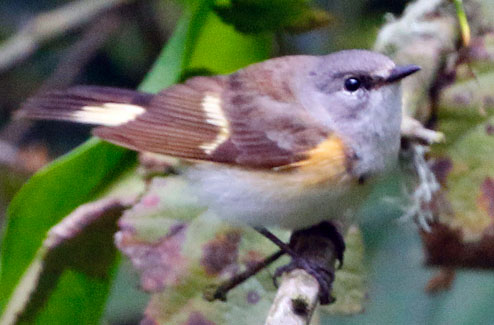 |
|
| Additional "eastern" warbler vagrants were at Big Sur R. mouth in Andrew Molera SP, and all of them were singing males: a Tennessee Warbler on 18 May (Karen Kreiger), a Chestnut-sided Warbler on 9 June (Mark Kudrav), and a Black-and-white Warbler on 10 June (D. Roberson, R. Carratello). Another singing Black-and-white was at Pt. Lobos on 16 June (photo Stephanie Martin). In addition, a Tennessee Warbler at Laguna Grande Park from 5-8 April (photo John Kuenzli) was perplexing: was it an extremely early spring migrant, or a wintering individual that had gone undetected, or something else? No one knows. |
|
| A welcome set of three Peregrine Falcon nestlings were spotted in the "Peregrine nest box" atop the Embassy Suites Hotel in Seaside in late May (Rita Carratello; the photo (below) is a collage of one adult near the nest on 25 May, and the 3 fuzzy white babies (with dark ear-coverts) in the nest box on 31 May; © D. Roberson). We fondly recall that the first Peregrines to nest on a local 'skyscraper' near the shore of Monterey Bay were a pair that used this same nest box in 2020 (nestlings first seen 21 May 2020). By June, four nestlings were documented (Amanda Preece, et al.). Back in 2020, the youngsters fledged during the 3rd week of June, and it seems the same timing applied to this June. The nest box was empty by 25 June. |
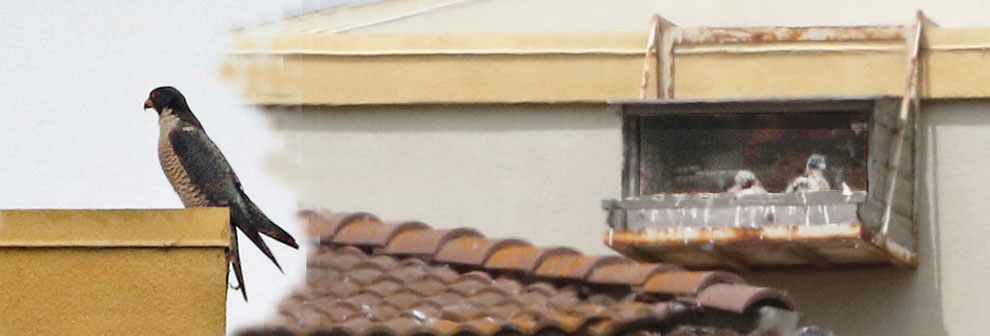 |
|
Sometimes visiting sailboats drop anchor off the Commercial Wharf (aka "Wharf #2") in Monterey Harbor. Birders have noticed that if the boat remains anchored for a very long time, Western Gulls may even nest on such a boat. Never before has a birder found a booby sitting on a moored sailboat in Monterey Harbor, but that's just what Jeerapa Sookgaew spotted aboard the Mary Louise on 10 May (above left, photo from 11 May © Don Roberson)! It proved to be a Red-footed Booby (above right, photo 12 May aboard the Panache, © Mark Chappell). The booby left its roost daily, presumably to fish offshore, and later returned. It was present into late June. It is a dark morph, presumably of the eastern Pacific race websteri, and well along towards adult plumage. [Check out the Monterey Harbor Hotspot.]
Red-footed Booby is a bird of warm equatorial oceans around the globe. It is well-known for riding on ships at sea. During a research cruise in 1989, where I was collecting seabird data for NOAA, one Red-foot roosted on our ship every night, and used the ship as a hunting perch for flying fish flushed at the bow. In 1987 there was an unusual incursion into California seas (6 records, 2 in MTY). However, starting in 2018, there have been Red-footed Boobies in and around Monterey Bay every year, with a dozen records between coastal MTY and SCZ. Some of these records are surely the same bird as other sites, but still, this is a dramatic change. We attribute the new incursion of Red-footed Boobies to global warming.
A Red-footed Booby in Santa Cruz last autumn made headlines by sitting on the Municipal Wharf and permitting close approach; on 17 Nov 2022 it was taken into rehab by Animal Bird Rescue. [I don't know if it was banded in rehab or if it was released.] People ask if the Monterey Harbor booby is one of the previous boobies of the last few years. The legs do not appear to be banded in the photos. The bill color is different from prior birds but, of course, bill color changes as a booby gets older. It has been over 5 months since there was a known Red-foot at sea here in Monterey Bay, so your guess is as good as mine. |
Late in May, two colorful discoveries drew the attention of local birders. On 14 May, at the "after-party" breakfast for Cornell's "global Big Day" the previous day, Brian Sullivan found a singing Indigo Bunting at Rancho Cañada in Palo Corona Regional Park in lower Carmel Valley. It continued to sing on territory a week later (below left, photo 16 May, © Bill Hill). Indigo Bunting was once a more regular spring, summer, and fall vagrant than it has been in recent years — when it attempted to breed here — but there were two singing males at Rancho Cañada in late May 2018.
A much rarer vagrant is Yellow-throated Vireo. With the discovery of a singing male along the Big Sur River in Andrew Molera SP by Karen Kreiger on 18 May, there are now 14 MTY records (below right, photo © Karen Kreiger). 64% of our records of this southeastern U.S. vireo have been in spring migration. Some have been one-day-wonders and others have lingered (this year's bird was still present until at least 20 May), but here is a list of the "arrival" dates when these spring vagrants were found: 19 May 2001, 8 June 2002, 20 May 2004, 17 June 2009, 26 May 2012, 28 May 2017, 29 May 2017 (2d bird at Rancho Cañada that year), 30 May 2021, and 18 May 2023. This year's bird is the earliest (by 1 day), and half of the county's records were found in the last 14 days of May. We can call that a pattern. Plus, all the records have been along either the Big Sur or the Carmel River, with 6 records in Andrew Molera SP, and 3 in Palo Corona Regional Park. If you want to find the next Yellow-throated Vireo in MTY, head to one of those public parks in late May. |
|
There are times when I like to follow a bird around long enough to get a photo of it in flight. It takes a lot more time and effort than a typical "perched bird" shot, but it can be fun. Here's a Western Wood-Pewee just leaving its perch in my Pacific Grove yard that I worked to obtain this spring (4 May, right).
Within a week we ran into another photographer at the Frog Pond Nature Reserve — Mark Daoud — who has taken this approach to another level. He's been working on getting flight shots of colorful passerines (swallows, orioles, tanagers) for the beauty and aesthetics of the results. As it happens, by spending time taking flight shots of common birds, Mark managed to photograph two vagrants in the process.
The first is this male Summer Tanager from the Frog Pond on 10 May (© Mark Daoud), which remained through 12 May. Mark's flight shot (just below) certainly gives us a different perspective on a Summer Tanager, and his perched photo is very nice as well (below right).
|
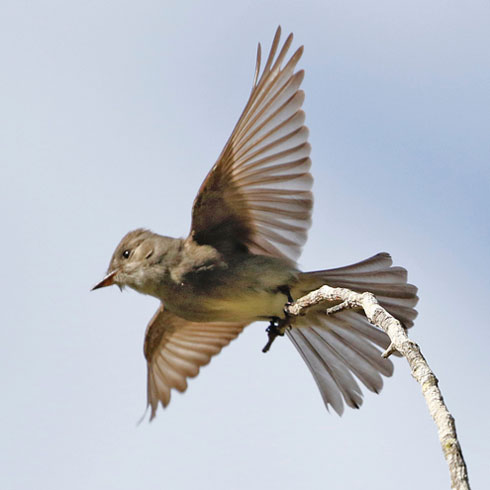 |
 |
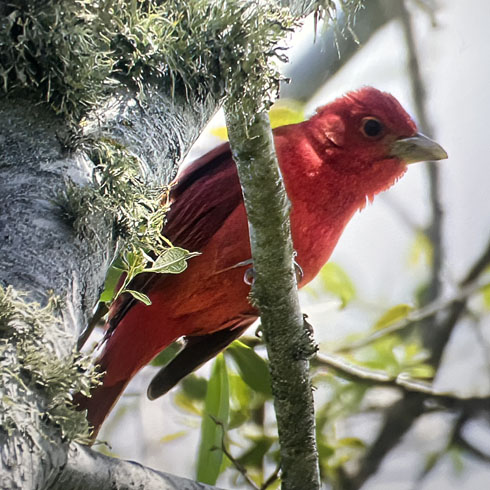 |
A week later, when visiting Rancho Cañada in Palo Corona Regional Park, I happened to run into Mark again. He had been spending time there in an effort to get photos of Lazuli Bunting in flight. On 17 May he did get this in-flight Lazuli setting up to land in a bare tree (right; © Mark Daoud) — but only later noticed that another colorful bird was in the photo: a male Rose-breasted Grosbeak!
In MTY we usually record a few Rose-breasted Grosbeak in spring and summer, but rarely are they discovered while photographing a different bird. Between 13 May–17 June this year, at least 7 Rose-breasted Grosbeaks were reported — and 5 of them were at the feeder or backyard of local observers. It turned out that we also had at least 7 Summer Tanagers in MTY in May-June; two of them were in backyards.
Among surprising mid-May vagrants were a courting pair of dark-morph Swainson's Hawk at the Marina landfill on 13 May (Brian Sullivan and a Cornell "global Big Day" team). The last nesting pair in MTY was back in the 1970s (Roberson 2002), but now these hawks breed near to MTY in both San Benito and San Luis Obispo counties. Two Evening Grosbeaks on 15 May (Brian Sullivan) were quite late. |
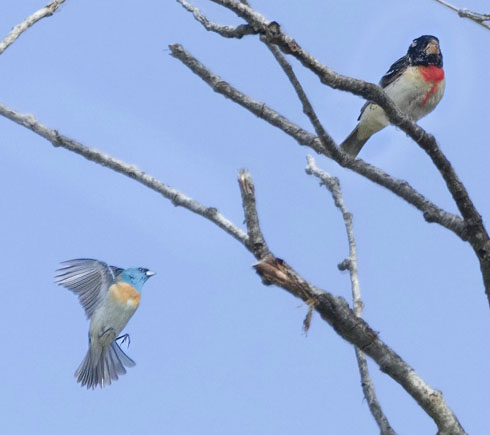 |
|
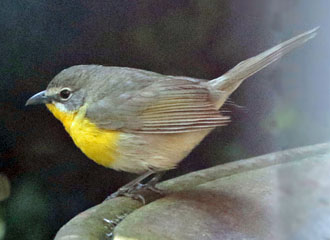 |
Yellow-breasted Chat appeared in at least 3 yards this spring: Pebble Beach 26 Apr (Jeff Froke), Pacific Grove 11 May (left, ph © D. Roberson, R. Carratello), and in Mal Paso Canyon 13-14 May (right, ph © Karen Kreiger). A few migrate along riparian corridors like the Carmel River each spring, but chats are unusual away from the rivers. One impressive chat was singing at Pt. Pinos on 5 May (Gary Dial), just the 2d record for that heavily birded site [check out the Pt. Pinos Hotspot]. Three more chats this spring included one at Pt. Lobos. |
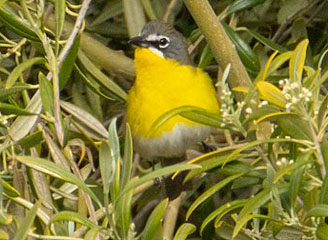 |
|
| |
A Blackburnian Warbler described from a Pebble Beach yard on 14 March (Mark Chappell) was very unusual. If it spent the winter in Pebble Beach, it would be only the second Blackburnian to winter in MTY. Last fall was an excellent migration for eastern warblers (see late 2022 report), including six different Blackburnian. One of those was at Pt. Lobos State Reserve on 7 Dec 2022. In writing about that hatch-year bird, I wrote that it "had an exceedingly short stay (15 minutes) in the wispy Lace Lichen on cypresses at the tip of Pt. Lobos before flying off towards Pebble Beach ....". [Check out the Pt. Lobos Hotspot.]
What are the odds that the Pt. Lobos Blackburnian in December that flew towards Pebble Beach was the one Mark Chappell saw in his yard in March? The odds seem incalculable but stranger things have happened. The one time a Blackburnian was known to spend the entire winter at a spot in MTY was back in 1986-1987, some 36 years ago. That Blackburnian was found on the Christmas Bird Count on Short Street in Pacific Grove (D. Roberson), and ended up providing full wintering dates from 29 Dec 1986–22 Mar 1987. This year's bird in Pebble Beach on 14 March is within the known date-span of a locally wintering individual. |
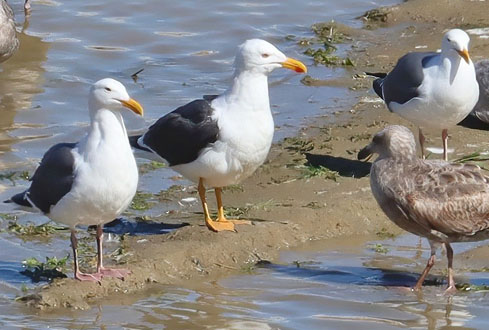 Steve Tucker has become the Gull Guru for 2023, finding the best two larids of the winter and single-handedly adding a new species to the Monterey County checklist: Yellow-footed Gull Larus livens. It was among 7000 gulls at the Marina Landfill on 11 March (photo left, © Steve Tucker; it is the middle adult gull standing on a mudflat with heavy bill, yellow iris, and yellow legs and feet, with a slight orange tint). Fortunately, Steve got a series of very useful photos, on the ground and in flight, and reviews by experts were positive. Unfortunately, the gull flew away from the bathing spot it was briefly using, in a swale below the dump, and was not seen by any of the rest of us. It is likely this is the same Yellow-footed Gull, found by Lois Goldfrank and photographed by Paul Heady, in Santa Cruz on 17 Dec 2022. If the December Santa Cruz gull is the same as the Marina gull in March, it stands as the lone record for northern California. The MTY county list now stands at 502 species. [Check out the Marina Landfill (restricted access) Hotspot.] Steve Tucker has become the Gull Guru for 2023, finding the best two larids of the winter and single-handedly adding a new species to the Monterey County checklist: Yellow-footed Gull Larus livens. It was among 7000 gulls at the Marina Landfill on 11 March (photo left, © Steve Tucker; it is the middle adult gull standing on a mudflat with heavy bill, yellow iris, and yellow legs and feet, with a slight orange tint). Fortunately, Steve got a series of very useful photos, on the ground and in flight, and reviews by experts were positive. Unfortunately, the gull flew away from the bathing spot it was briefly using, in a swale below the dump, and was not seen by any of the rest of us. It is likely this is the same Yellow-footed Gull, found by Lois Goldfrank and photographed by Paul Heady, in Santa Cruz on 17 Dec 2022. If the December Santa Cruz gull is the same as the Marina gull in March, it stands as the lone record for northern California. The MTY county list now stands at 502 species. [Check out the Marina Landfill (restricted access) Hotspot.]
Three weeks earlier, Steve Tucker found and photographed a first-cycle Lesser Black-backed Gull in the huge gull roost at the Salinas River mouth. I think this is the 9th record for MTY. |
 |
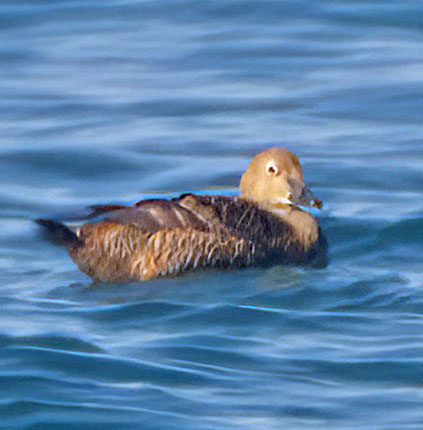 Perhaps the most sought after birds in the first half of 2023 were two King Eider together on the ocean off Asilomar SB, Pacific Grove, from 16 February-13 April. Found by Don Roberson & Rita Carratello, while scoping the scoter flock in which Bill Hubick had found a Long-tailed Duck earlier on 16 Feb, these two female-plumaged eiders stayed close to each other, and also close to same scoter/grebe flock for nearly two months. They were both watched diving for mussels, as scoters do, and having success in finding prey. With the winter storms, the coastline was typically subjected to huge, pounding waves hitting the shore, and making it difficult to scope the eiders as they "appeared and disappeared" between the wave troughs [and difficult to photograph! Both photos here are © Mark Chappell, from 16 Feb; the two together (above) are near a Common Loon]. Still, these two eiders stayed at more-or-less the same location — off Asilomar gate #7 —most of the time. During their stay they occasionally were a bit farther offshore, or had ranged a bit south towards Spanish Bay, but seemed basically settled in. Perhaps the most sought after birds in the first half of 2023 were two King Eider together on the ocean off Asilomar SB, Pacific Grove, from 16 February-13 April. Found by Don Roberson & Rita Carratello, while scoping the scoter flock in which Bill Hubick had found a Long-tailed Duck earlier on 16 Feb, these two female-plumaged eiders stayed close to each other, and also close to same scoter/grebe flock for nearly two months. They were both watched diving for mussels, as scoters do, and having success in finding prey. With the winter storms, the coastline was typically subjected to huge, pounding waves hitting the shore, and making it difficult to scope the eiders as they "appeared and disappeared" between the wave troughs [and difficult to photograph! Both photos here are © Mark Chappell, from 16 Feb; the two together (above) are near a Common Loon]. Still, these two eiders stayed at more-or-less the same location — off Asilomar gate #7 —most of the time. During their stay they occasionally were a bit farther offshore, or had ranged a bit south towards Spanish Bay, but seemed basically settled in.
That they "settled in for the winter" here was interesting because the evidence suggests that these two females — possibly an adult female and a first-year female offspring? — arrived here after a long, erratic, and adventurous journey. eBird entries report two female-plumaged King Eiders, staying together, were present at Lake Hattie Reservoir, Wyoming, from 12-18 Nov 2022 (1st Wyoming record!). They were "off the radar" for a month, but then two female King Eiders, staying together, were at Ventura Pier, Ventura Co., California, from 25 Dec 2022 to 5 Feb 2023. They next turned up well north at Crissy Field, San Francisco, on 10 Feb 2023, and then back-tracked south to Asilomar SB, where discovered on 16 February. The concept of a female and offspring is just hypothesis, and these might be two unrelated females together, but it is quite curious. Typically, young eiders don't migrate south with an adult — geese and swans often migrate south in family groups — but this is not documented for King Eider, per Cornell's Birds of the World. [Check out the Asilomar SB--rocky shore--Hotspot.]
All prior MTY records have been of single eiders, but some of them lingered for many months. Ten King Eider records are cited in Roberson (2002). The most recent was one that summered at Moss Landing in 1991. King Eiders were seen more often in and around Monterey Bay during the 1970s-1980s, but with global warming, it seems that the southern edge of the wintering range has moved northwards. King Eider was a County bird or even a State bird for most current local birders, and for a lot of visitors, except the really old-timers. |
| |
 Winter 2023 was marked by "atmospheric rivers" of moisture, bringing drought-ending rain, strong winds, multiple power outages that lasted for days, and flooding. The Pajaro River flooded the town of Pajaro; both the Salinas and Carmel Rivers nearly reached flood stage. Andrew Molera SP eventually closed due to flooding. Jacks Peak Park closed due to downed trees. A landslide blocked Highway 1 south of Big Sur, and it is still closed in May. In short, birding was not as much a priority for many from January into March. There were two Yellow-bellied Sapsucker (one returning for a second winter in Pacific Grove; Gary Dial) and two Red-naped Sapsuckers in early January, but all disappeared by 20 Jan (this female Red-naped Sapsucker, right, hung upside down in the orchard at Andrew Molera SP on 3 January to reach a ripe persimmon between rain-storms; photo © D. Roberson). Winter 2023 was marked by "atmospheric rivers" of moisture, bringing drought-ending rain, strong winds, multiple power outages that lasted for days, and flooding. The Pajaro River flooded the town of Pajaro; both the Salinas and Carmel Rivers nearly reached flood stage. Andrew Molera SP eventually closed due to flooding. Jacks Peak Park closed due to downed trees. A landslide blocked Highway 1 south of Big Sur, and it is still closed in May. In short, birding was not as much a priority for many from January into March. There were two Yellow-bellied Sapsucker (one returning for a second winter in Pacific Grove; Gary Dial) and two Red-naped Sapsuckers in early January, but all disappeared by 20 Jan (this female Red-naped Sapsucker, right, hung upside down in the orchard at Andrew Molera SP on 3 January to reach a ripe persimmon between rain-storms; photo © D. Roberson).
A favorite vagrant in Pacific Grove, seen and photographed by many locals and visiting birders, made it through all the wild winter weather. That was a Lewis's Woodpecker on Lincoln Street (below; photo 19 Feb, © D. Roberson). Discovered on 29 January by Fred Hochstaedter and Catherine Webb, it stayed through at least 6 March. Any Lewis's Woodpecker in Pacific Grove is out-of-place and from somewhere in the interior West; it is quite unusual to have one winter here. [Lincoln Street is within a Pacific Grove enclave adjacent to Del Monte Forest, with access to the multi-trailed Reserve; check out the Del Monte Forest--SFB Morse Botanical Reserve Hotspot.]
|
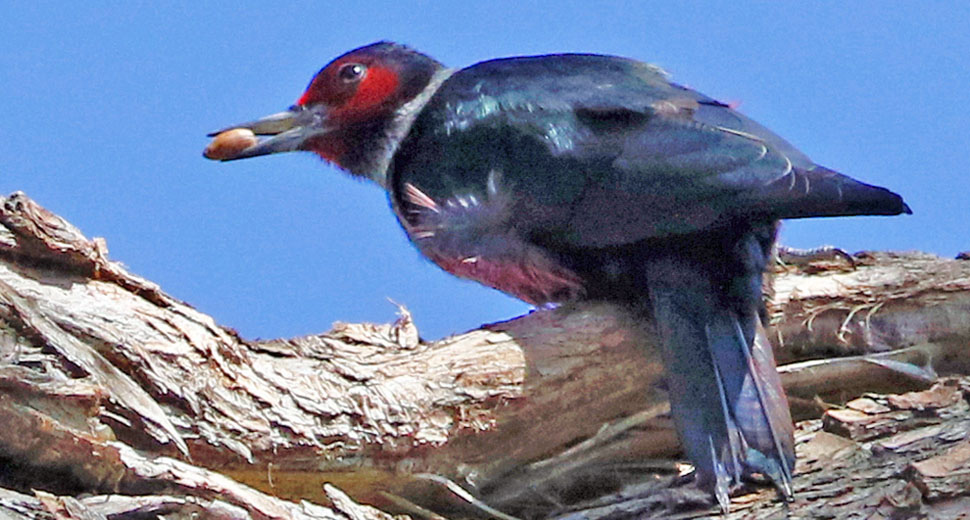 |
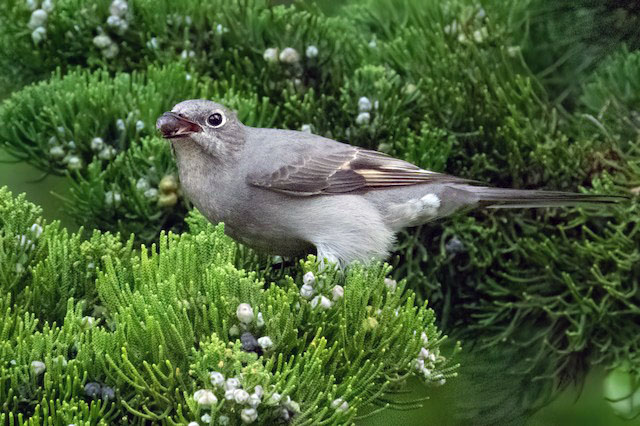
Two unexpected passerines were discovered between storms in late December 2022 and January 2023. Paul Fenwick found a Townsend's Solitaire gorging on berries in a fruiting tree on the Monterey Peninsula College campus during the Monterey Peninsula Christmas Bird Count on 29 Dec 2022. It routinely appeared to gobble fruit until at least 22 January (photo right, 7 Jan © Karen Kreiger). We now have more than a dozen winter records of Townsend's Solitaire in MTY, but most are from higher elevations in the Santa Lucia Mountains. This is the first winter bird within the City of Monterey.
In the City of Salinas, a male Vermilion Flycatcher appeared during an annual habitat stewardship event at Carr Lake on 21 January (Mike Stake, Amanda Preece, Shawn Wagoner, Steve Rovell). It represented the 15th MTY record. |
| |
Literature cited:
- Roberson, D. 2002. Monterey Birds, 2d ed. Monterey Audubon Soc., Carmel, CA.
- Roberson, D., and C. Tenney, ed. 1993. Atlas of the Breeding Birds of Monterey County, California. Monterey Audubon Soc., Carmel, CA.
I thank Rita Carratello, Bill Hubick, and Michael Rieser for editorial comments on an earlier draft of this page.
|
|
Page created 18-21 May 2023, updated 25 June 2023
TOP
GO TO
HOME PAGE
TO MONTEREY
COUNTY
PAGE
TO BIRD
FAMILIES
OF THE WORLD
|


 Perhaps the most sought after birds in the first half of 2023 were two King Eider together on the ocean off Asilomar SB, Pacific Grove, from 16 February-13 April. Found by Don Roberson & Rita Carratello, while scoping the scoter flock in which Bill Hubick had found a Long-tailed Duck earlier on 16 Feb, these two female-plumaged eiders stayed close to each other, and also close to same scoter/grebe flock for nearly two months. They were both watched diving for mussels, as scoters do, and having success in finding prey. With the winter storms, the coastline was typically subjected to huge, pounding waves hitting the shore, and making it difficult to scope the eiders as they "appeared and disappeared" between the wave troughs [and difficult to photograph! Both photos here are © Mark Chappell, from 16 Feb; the two together (above) are near a Common Loon]. Still, these two eiders stayed at more-or-less the same location — off Asilomar gate #7 —most of the time. During their stay they occasionally were a bit farther offshore, or had ranged a bit south towards Spanish Bay, but seemed basically settled in.
Perhaps the most sought after birds in the first half of 2023 were two King Eider together on the ocean off Asilomar SB, Pacific Grove, from 16 February-13 April. Found by Don Roberson & Rita Carratello, while scoping the scoter flock in which Bill Hubick had found a Long-tailed Duck earlier on 16 Feb, these two female-plumaged eiders stayed close to each other, and also close to same scoter/grebe flock for nearly two months. They were both watched diving for mussels, as scoters do, and having success in finding prey. With the winter storms, the coastline was typically subjected to huge, pounding waves hitting the shore, and making it difficult to scope the eiders as they "appeared and disappeared" between the wave troughs [and difficult to photograph! Both photos here are © Mark Chappell, from 16 Feb; the two together (above) are near a Common Loon]. Still, these two eiders stayed at more-or-less the same location — off Asilomar gate #7 —most of the time. During their stay they occasionally were a bit farther offshore, or had ranged a bit south towards Spanish Bay, but seemed basically settled in. 

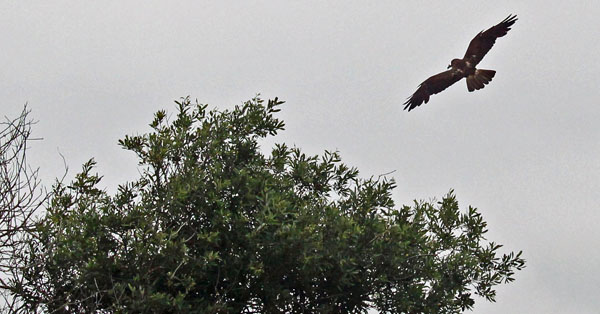
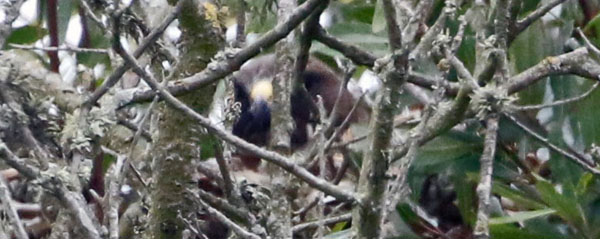





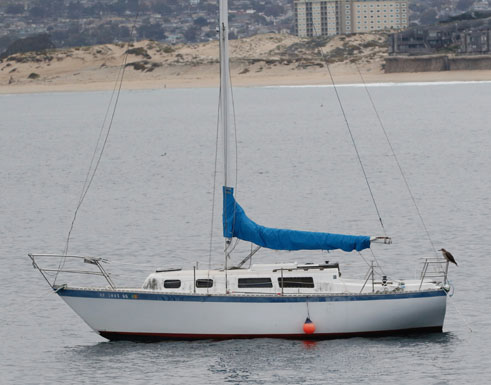









 Steve Tucker has become the Gull Guru for 2023, finding the best two larids of the winter and single-handedly adding a new species to the Monterey County checklist: Yellow-footed Gull Larus livens. It was among 7000 gulls at the Marina Landfill on 11 March (photo left, © Steve Tucker; it is the middle adult gull standing on a mudflat with heavy bill, yellow iris, and yellow legs and feet, with a slight orange tint). Fortunately, Steve got a series of very useful photos, on the ground and in flight, and reviews by experts were positive. Unfortunately, the gull flew away from the bathing spot it was briefly using, in a swale below the dump, and was not seen by any of the rest of us. It is likely this is the same Yellow-footed Gull, found by Lois Goldfrank and photographed by Paul Heady, in Santa Cruz on 17 Dec 2022. If the December Santa Cruz gull is the same as the Marina gull in March, it stands as the lone record for northern California. The MTY county list now stands at 502 species. [Check out the
Steve Tucker has become the Gull Guru for 2023, finding the best two larids of the winter and single-handedly adding a new species to the Monterey County checklist: Yellow-footed Gull Larus livens. It was among 7000 gulls at the Marina Landfill on 11 March (photo left, © Steve Tucker; it is the middle adult gull standing on a mudflat with heavy bill, yellow iris, and yellow legs and feet, with a slight orange tint). Fortunately, Steve got a series of very useful photos, on the ground and in flight, and reviews by experts were positive. Unfortunately, the gull flew away from the bathing spot it was briefly using, in a swale below the dump, and was not seen by any of the rest of us. It is likely this is the same Yellow-footed Gull, found by Lois Goldfrank and photographed by Paul Heady, in Santa Cruz on 17 Dec 2022. If the December Santa Cruz gull is the same as the Marina gull in March, it stands as the lone record for northern California. The MTY county list now stands at 502 species. [Check out the  Winter 2023 was marked by "atmospheric rivers" of moisture, bringing drought-ending rain, strong winds, multiple power outages that lasted for days, and flooding. The Pajaro River flooded the town of Pajaro; both the Salinas and Carmel Rivers nearly reached flood stage. Andrew Molera SP eventually closed due to flooding. Jacks Peak Park closed due to downed trees. A landslide blocked Highway 1 south of Big Sur, and it is still closed in May. In short, birding was not as much a priority for many from January into March. There were two Yellow-bellied Sapsucker (one returning for a second winter in Pacific Grove; Gary Dial) and two Red-naped Sapsuckers in early January, but all disappeared by 20 Jan (this female Red-naped Sapsucker, right, hung upside down in the orchard at Andrew Molera SP on 3 January to reach a ripe persimmon between rain-storms; photo © D. Roberson).
Winter 2023 was marked by "atmospheric rivers" of moisture, bringing drought-ending rain, strong winds, multiple power outages that lasted for days, and flooding. The Pajaro River flooded the town of Pajaro; both the Salinas and Carmel Rivers nearly reached flood stage. Andrew Molera SP eventually closed due to flooding. Jacks Peak Park closed due to downed trees. A landslide blocked Highway 1 south of Big Sur, and it is still closed in May. In short, birding was not as much a priority for many from January into March. There were two Yellow-bellied Sapsucker (one returning for a second winter in Pacific Grove; Gary Dial) and two Red-naped Sapsuckers in early January, but all disappeared by 20 Jan (this female Red-naped Sapsucker, right, hung upside down in the orchard at Andrew Molera SP on 3 January to reach a ripe persimmon between rain-storms; photo © D. Roberson).